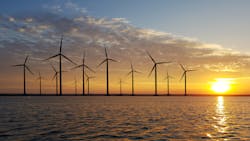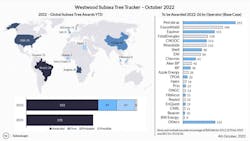Editor's note: This Subsea Systems column first appeared in the November-December 2022 issue of Offshore magazine. Click here to view the full issue.
By Ariana Hurtado, Houston
Industry responds to floating wind growth, technology's move into deeper water
Offshore wind developers are seeking engineering expertise and subsea technologies to explore new concepts and designs for offshore wind turbines as well as knowledge about cables and structural dynamics.
As more companies initiate floating wind projects specifically, technology development, conceptual design, FEED, procurement, construction, installation, operations and decommissioning all have their own set of deepwater hurdles that need to be addressed.
“Floating wind is currently in a period of hyper-growth,” Spinergie analyst Yvan Gelbart told Offshore.
Instead of being locked to the seabed floor via a fixed structure like conventional offshore wind, floating wind projects use floating platforms anchored to the seabed using mooring chains.
Of the total 30 turbines with more than 1-MW capacity commissioned globally, 23 of them have been commissioned in the past five years, excluding China and Brazil. Overall installed capacity is about 130 GW as of 2022, according to Spinergie analysis.
“In response to this level of growth, some governments (e.g., the UK and US) are providing ongoing initiatives to support this technology as it moves into deeper and more logistically difficult waters,” Gelbart said. “An upcoming example would be the US wind market moving into deeper waters with California’s 4.5-GW auction for floating wind in water depths ranging from 500 to 1,200 m. It will take place this December and marks the first floating wind auction for the US—a market currently dominated by fixed-bottom wind projects.”
Installations and investments in the global offshore wind industry are set to surge this decade, Rystad Energy reported in June, adding that total capex is projected to more than double from $46 billion in 2021 to $102 billion in 2030. How much of that will be attributed to floating wind was not stated in the report.
“Floating wind offers several advantages over conventional fixed-bottom offshore wind, the most obvious of which is that floating turbines can be located in seabed depths of several hundred meters, compared with a maximum of around 65 m for fixed-bottom,” according to an Energy Monitor report. “This allows far more flexibility in where it is put. Offshore wind can already access higher wind speeds than onshore, but this allows floating wind to take advantage of the very best spots.”
Floating wind projects in deeper waters result in a larger resource (e.g., stronger winds). However, this also comes along with higher costs. Some sources state that floating wind farms can be anywhere from two to four times higher than the price of fixed-bottom offshore wind projects. Fortunately, according to the Energy Monitor report, the gap between fixed-bottom and floating offshore wind is expected to narrow.
“During this time, it is crucial to consider the importance of keeping the costs of these projects down,” Gelbart added. “This is especially crucial in countries like Spain where floating wind is the only commercial-size wind option available due to water depth. Currently, it is the UK, Italy, Ireland and South Korea that are driving the most interest from floating wind developers with approximately 50 GW of projects unveiled for those countries’ waters.”
Last year Stiesdal Offshore and its partners announced that the TetraSpar Demonstration Project was officially commissioned and in operation off Norway in a water depth of 200 m. The consortium, comprising Shell, RWE, TEPCO Renewable Power and Stiesdal, said this project is the world’s first full-scale demonstration of an industrialized offshore foundation.
“Over the last few years, there have been many demonstrator projects in floating wind technology; however, all have been on a small scale,” Gelbart said. “As the industry continues to seek new ways of building floating offshore wind farms, we understand that another 57 floating turbines are expected by 2026 within 19 demonstrator projects, excluding China and Brazil.”
Recently, there have been several reports of contracts for offshore substations. For instance, Atlantique Offshore Energy won contracts in October to design, manufacture and commission the offshore substation topsides required for the Yeu-Noirmoutier and Dieppe Le Tréport offshore wind farms offshore France. Each of these wind farm projects involves the installation of 62 wind turbines with a capacity of 8 MW, for a total power output of almost 500 MW.
And in September, Bladt Industries and Semco Maritime announced they will jointly supply two offshore substations for the Baltic Power wind farm development, 23 km offshore Poland. The development will comprise more than 70 turbines, each with a minimum capacity of 14 MW.
Moreover, Saipem and Siemens Energy signed a memorandum of understanding in early September to jointly develop the design for a 500-MW high-voltage alternating current floating electrical substation for offshore wind farms. According to Saipem, floating offshore substations in deepwater provide benefits such as a lighter substructure, a simpler, asset-light installation in rougher conditions, and reduced final decommissioning costs. The concept will be based on a semisubmersible substructure and designed to operate in extreme offshore environments with enhanced stability, with the potential to scale up in size as requested by clients.
“One of the industry’s main targets is to find solutions to create commercial-size floating wind farms while simultaneously driving down costs. This is a major challenge for developers as they will have to install offshore substations [OSS] in waters hundreds of meters deep,” Gelbart continued. “To date, the only floating OSS in the world was built almost a decade ago in Japan (2013) and is connected to just three turbines. The key for developers will be to scale up these solutions in line with commercial-size wind projects.”
Moving forward, developers have announced many floating wind projects totaling 75 GW by 2030, excluding China and Brazil, but many are likely to be delayed, according to Spinergie analysis.
The GWEC expects 16.5 GW of floating wind by 2030, while WindEurope says 10 GW, and Bloomberg and Orsted expect 5.5 GW. “This wide disparity of expectations highlights the many uncertainties the market currently holds about scalability in floating wind,” Gelbart concluded.
Global update on subsea tree awards
The third-quarter 2022 subsea tree order intake closed at 38 units, bringing recorded tree awards year to date closed at 183 units, according to Westwood’s Global Subsea Tree Tracker report released Oct. 4. However, announced subsea tree awards for bp's Cypre development (Trinidad and Tobago) and Shell’s Geronggong development (Malaysia) is imminent, following a final investment decision (FID) on these projects during the period under review.
In fourth-quarter 2022, subsea tree awards will be dominated by activities offshore Norway, with Equinor’s Wisting development expected to account for 36 subsea tree units, while Aker BP’s NOA Fulla project will account for an additional 20 units, the report stated. Other major awards anticipated before year-end 2022 include Shell’s Gato do Mato and additional tree award for Petrobras’ Buzios development, both offshore Brazil.
Westwood's full-year 2022-2026 subsea tree demand outlook is forecast at approximately 1,560 units, a marginal decrease of 1% compared to last month’s forecast.





